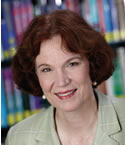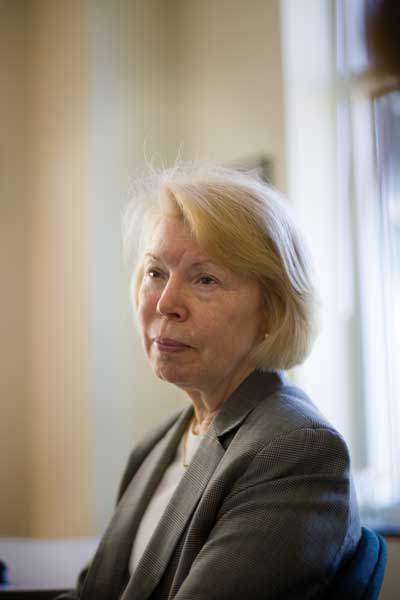Nationally, half of all nurses working today were born during the baby-boom years. What will happen as they near traditional retirement age? To prevent a mass exodus from the profession, nursing leaders at Johns Hopkins are looking for innovative ways to keep experienced nurses contributing—well past age 65.
Written by Jim Duffy

Never before had Penny Dvorak ’61 found herself at a career crossroads. Growing up in Oak Ridge, Tennessee in the 1940s, she’d always wanted to be a nurse. She even knew where she’d like to go to nursing school, thanks to a small-town physician who enjoyed talking up his alma mater, Johns Hopkins.
Dvorak arrived in Baltimore in 1958, fresh out of high school and utterly overwhelmed by the big city. Then she stepped into Hopkins Hospital for the first time and found herself looking up into the arms of the Christ statue. Everything felt okay again, so much so that she stuck around for the next 46 years—and counting.
The course of Dvorak’s career was set during a student rotation through the operating room. She liked the pace, the teamwork, and the intensity of it. After graduating from the School of Nursing in 1961, she took a job in the GYN operating room. Aside from one brief detour into the general operating room in the mid-1960s, she’s been with the same unit ever since.
“I love this OR,” Dvorak says. “I love the people I work with. I love that you’re totally focused on only one patient at a time. I love that you’re working right along with the surgeons and the house staff and the anesthesiologists. I get a lot of satisfaction out of what I do.”
Four years ago, her unit moved into the newly constructed Weinberg Building. The building’s opening gave hospital brass the opportunity to do all manner of logistical shuffling among the units. One such change meant that Nelson 2 OR nurses would now be expected to take on occasional shifts in the general operating room.
Dvorak knew she could do the GOR work. But she had just turned 60 years old. She was two years shy of being able to draw on her pension. She didn’t have to endure the craziness and stress of all those unfamiliar gunshot and trauma surgeries in the GOR. She could just walk away.
Then again, there was a familiar voice in the back of her head. “My mother always said she’d rather wear out than rust out,” Dvorak says, her Tennessee roots gaining strength in her voice. “I’ve always worried that if I just quit one day and sit myself down, I might not ever be able to get back up.”
For the first time in her nursing life, Dvorak didn’t know whether she should stay or go.
******************
As vice president for nursing at Johns Hopkins Hospital, Karen Haller grapples with a never-ending procession of big-picture numbers buried in ringed binders containing annual budgets, strategic plans, and staffing updates. Vexing numerical puzzles are a constant in the hospital, with ever-shifting monthly, annual, and long-term trends involving personnel, patients, dollars, beds, units, and supplies threatening constantly to fall out of balance and into crisis.
In recent years, one aspect of this juggling act has been especially vexing: the nursing shortage.
In addition to luring new nurses into the field and keeping mid-career nurses happy and on the job, Haller is worried about losing the field’s most seasoned professionals. “The baby boomers are going to be retiring, and they’re going to be retiring in numbers that are just unprecedented,” she says.
Nationally, nearly half of all nurses working today were born in the baby-boom years, between 1947 and 1962. The older baby-boom nurses are now deep into their 50s. Many have already begun to withdraw from the labor force, switching to part-time positions or seeking work in school or insurance settings that are less stressful and demanding than hospital bedsides.
When the oldest of these nurses hit retirement age, it will mark the beginning of an exodus from the nursing profession of astounding proportions. Most experts point to 2010 as the year the next—and possibly biggest—wave of the shortage begins to crest.
“It scares the bedoodle out of me,” says Pamela Thompson, chief operating officer of the American Organization of Nurse Executives (AONE). “It’s going to be very, very serious. We’ve never had a prediction of a shortage anywhere near this big. And I haven’t heard anybody out there dispute the numbers.”
That’s why Hopkins’ Haller is so interested nowadays in the choices made by nurses as they approach and then pass retirement age. Why do they stay? Why do they go? What can Hopkins do to keep more of them on the job longer, thereby retaining their years of expertise? The way the numbers buried in those binders on Haller’s desk shake out, the future of nursing—at least over the next decade or two—might very well depend on people like Penny Dvorak.
******************
Jeri Eichberg is not allowed to take vacations in July. This is not spelled out in any policy manual or detailed in any employment contract. It’s just the way things work in the emergency room of the Wilmer Ophthalmological Clinic at Hopkins. Everyone there knows that the experienced nurses need to be on the job during the month that every year sees nine new residents arrive at the clinic.
“They’ve been a year in medicine, maybe, or they’ve been a year in general surgery,” Eichberg says. “They depend on the nurses. They depend on us a lot.”
Eichberg has been through 42 Julys at Hopkins Hospital. Now 80 years old, she started as a private duty nurse in Marburg Pavilion, where the first patient she cared for was a physician by the name of Alfred Blalock. She was at Wilmer when former Director Morton Goldberg rotated through as a resident. She was at Wilmer when current Director Peter McDonnell rotated through.
“A nurse with that kind of experience can tell anybody what to do,” says Vicki Navarro, the nurse manager in charge of Eichberg’s unit. “They’re not going to be worried about calling someone at home or whether someone might get angry or whether someone is important. They’re just going to do what needs to be done.”
The respect that grows over time between physicians and experienced nurses is mutual. As she got into her 60s and then her 70s, Eichberg wondered now and again whether it was time for her to leave. But she enjoyed coming to work. She liked serving as an encyclopedic source of information about the “Wilmer Way” of doing things.
But was she slowing down? Could she be losing her skills without recognizing it?
“So I would ask the doctors,” Eichberg says, “and they just kept saying, ‘No, you don’t need to go. You’re doing fine. Stay on.’ So I’m still here.” On the occasion of her 80th birthday party, Wilmer named an emergency exam room in Eichberg’s honor.
******************
The next chapter in the nursing crisis won’t be a matter of numbers alone. As the baby-boom nurses leave, they will be taking with them their decades of experience and the confidence that comes with it. They will be taking with them institutional memories that run long and deep and bureaucratic skills that can make things happen quickly in a hospital as complex and unwieldy as Hopkins.
“When new nurses come in, they’re well-educated,” Haller says. “But many of them are focused on their skills. Can I draw that blood? Can I read that monitor? Can I put in that catheter? It takes a few years, really, before they get comfortable with all that. Then they start to see that nursing isn’t only about developing those skills. It’s about using those skills to put together a clinical picture in the best interest of the patient.”
The average age of a bedside nurse at Hopkins is 37, somewhat younger than the national average. Still, nearly 40 percent of the hospital’s nurses are older than 40.
“These experienced people are very valuable to me,” Haller says. “It’s not just a matter of whether we have enough nurses. It’s what’s in their heads. It’s in the way these people support young and inexperienced nurses. I don’t want to see that knowledge just walk out the door.”
Ann Minnick, the associate dean for research at the Rush University College of Nursing in Chicago, has studied the long-term patterns of the nursing workforce. She published a paper about the looming crisis surrounding the retention of older nurses in Nursing Outlook in 2000. It warned of “profound” challenges ahead, not just in sheer staffing numbers but in how an experience deficit could affect the ability of hospitals to institute all manner of new practices and technologies. In the years since, Minnick has gained quite a bit of practice sounding the alarm about the next wave of the shortage.
“There’s no getting around it, 2010 is coming,” she says. Her data show that one subgroup of the baby-boom nurses—people born between 1953 and 1956—comprise an “enormous percentage” of working nurses.
“And the nurses born in 1954 are turning 50 this year,” Minnick says. “What we know from repeated studies over the years is the older a nurse gets, the less likely she is to work in a hospital setting. And even if she is still working in a hospital, then as she gets older, she’s less likely to be working as a staff nurse.”
Now that the crisis is looming, a sense of urgency is growing. The American Organization of Nurse Executives plans to embark on an intensive study of the issue next year, highlighted by an effort to define best practices in nurse retention and address ways to tailor work environments to the needs of older nurses.
At Hopkins Hospital, the latter job is already under way. With two major new buildings scheduled to open in the next four years—a children and women’s clinic and a critical care tower—Haller has asked experts at the University’s Whiting School of Engineering to examine every aspect of the ergonomics of nursing work. Should stools have backs on them? Should counters be higher or lower? Can more cushioning be added to the floor, but not so much that it’s harder to roll equipment down the hall?
In addition, a hospital committee will study a host of other issues related to the retention of older nurses, including:
- Scheduling. Many nurses who reach their 50s and 60s no longer want to work the 12-hour shifts typical of the career. Many of them find it harder to endure the physical drain of switching between day and night shifts. Can all or some of the units at the hospital work with eight-, six-, or even four-hour shifts?
- Role issues. Not every late-career nurse needs to be engaged in traditional bedside work. Perhaps the hospital can expand its use of clinical resource nurses, who serve a troubleshooting role for entire units. Perhaps older nurses can spend more time training students and new arrivals.
- Management. What kind of new training or new authority might help nurse managers foster the development of work environments that are attractive to older nurses?
- Innovation. What kinds of new technologies can be put into place that would ease the physical burdens on older nurses?
- Benefits. Is it time for human resources experts to review pension and retirement policies? What would be involved in allowing nurses older than 62 to draw from their pensions while working more than 500 hours a year, the current limit? Is it possible to make health insurance benefits more available to older nurses working less than full-time schedules? Or even to retirees, once they’ve stayed on the job past a certain age?
Ann Minnick expects that this last item will be especially important. “This pension and health insurance business, every hospital is going to have to look at that, especially for the younger boomers,” she says.
At AONE, Pamela Thompson sees opportunity in the looming crisis as well as expense and risk. “This isn’t going to be a matter of tweaking,” she warns. “This is going to involve fundamental changes in the way we work. We’re going to have a different kind of workforce. It’s going to be older. It’s going to be fewer. What I think is going to happen here is a real shakeup that leads to really radical change. We can either be frightened by that, or we can be energized by the chance to make nursing better.”
At Hopkins’ School of Nursing, where the “graying” of the field—and the limited number of experienced nursing faculty now in the pipeline for education leadership—could threaten the future quality of nursing education, Dean Martha N. Hill, PhD, RN, FAAN ’64, is taking an optimistic approach. “For many of us, the ‘golden years’ of the traditional retirement stage of life can become the ‘golden opportunities’ of our careers,” she says. “Instead of retiring at what we believe to be the peak of our careers, we should look for ways to redefine our roles and, as senior educators with a wealth of experience, become the innovators of nursing education and the mentors and shapers of a new generation of outstanding nurses.” She continues, “The nursing profession now is in the enviable position of attracting some of the brightest and the best. They deserve the benefit of our years of experience, scholarship, and excellence.”
******************
Ask Penny Dvorak and Jeri Eichberg to play the role of a hospital vice president trying to keep retirement-age nurses on the job, and they’ve got no shortage of ideas to share.
Eichberg is adamant about the need for more flexible scheduling. Experienced nurses should get their choice of shifts, she says, just like experienced surgeons get their choice of operating room times. It was only last year—at age 79—that Eichberg began working only 12-hour dayshifts on Tuesdays, Wednesdays, and Thursdays.
“Seniority counts everywhere in this world,” she says. “Except here.”
Sixty-four-year-old Dvorak, the only nurse on her unit over 60, points first to health-insurance issues. Hopkins could create a strong incentive to stay on board by dangling the opportunity to gain access to group insurance plans in retirement, she says. She also wonders about all the roles experienced nurses could fill that do not involve a regular workday diet of turning 300-pound patients— anything from writing genuinely useful unit newsletters to taking on more mentoring and training assignments.
Dvorak’s own decision to continue working in the Weinberg OR is largely a tale of good, flexible management. Several years ago, she shared her concerns about taking on those stressful shifts in the general operating room with Candee Bartal, her unit manager. Bartal figured out a way to make everything work; for instance, one of the unit nurses who liked the GOR shifts took on more of them, freeing up Dvorak to take on new responsibilities associated with training newcomers and helping to manage payroll and attendance records.
“Part of staying was that I’m very dedicated to Johns Hopkins,” Dvorak says.
“But if it hadn’t been for Candee, I’d have been out the door.”
Karen Haller goes to her share of retirement parties for nurses who’ve decided to move on after devoting their working lives to Hopkins Hospital. While such parties are a time-honored workplace tradition, Haller has lately found herself looking out at all the assembled guests and musing about the message being delivered.
“Why is it that if you stay, we don’t do anything for you?” she asks with a laugh. “We don’t throw a party for you if you turn 65 and decide to stay on the job. It’s kind of perverse, actually. I want you to stay. I need you to stay. But you only get a party if you go!”
Penny Dvorak, for one, likes the idea. “Not bad,” she says. “I wouldn’t mind a party. They can call it a still-hanging-in-there party.”
Jim Duffy is a freelance writer who is based in Baltimore.
 What's the Violence-Depression Connection?
What's the Violence-Depression Connection? Faculty News
Faculty News Vicki Mock Recognized in Archives of the Johns Hopkins Medical Institutions
Vicki Mock Recognized in Archives of the Johns Hopkins Medical Institutions







